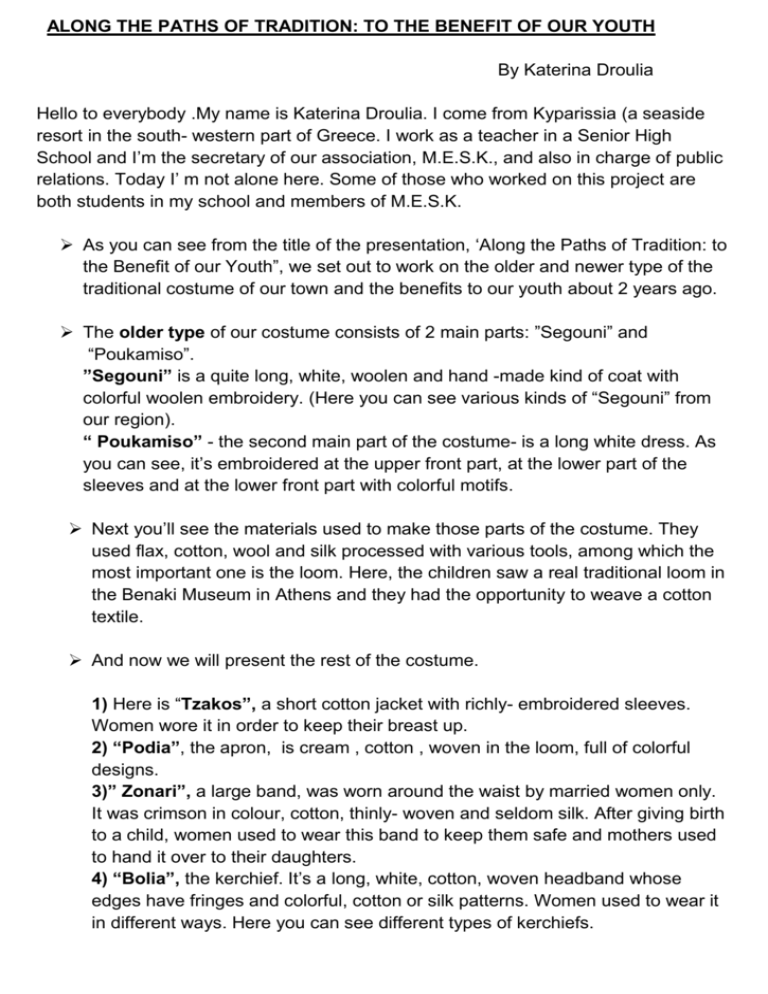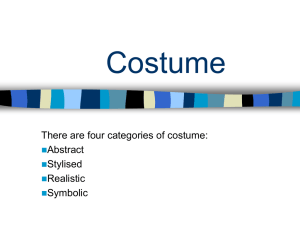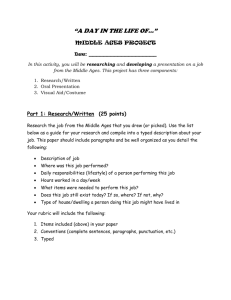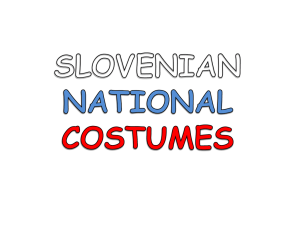ALONG THE PATHS OF TRADITION
advertisement

ALONG THE PATHS OF TRADITION: TO THE BENEFIT OF OUR YOUTH By Katerina Droulia Hello to everybody .My name is Katerina Droulia. I come from Kyparissia (a seaside resort in the south- western part of Greece. I work as a teacher in a Senior High School and I’m the secretary of our association, M.E.S.K., and also in charge of public relations. Today I’ m not alone here. Some of those who worked on this project are both students in my school and members of M.E.S.K. As you can see from the title of the presentation, ‘Along the Paths of Tradition: to the Benefit of our Youth”, we set out to work on the older and newer type of the traditional costume of our town and the benefits to our youth about 2 years ago. The older type of our costume consists of 2 main parts: ”Segouni” and “Poukamiso”. ”Segouni” is a quite long, white, woolen and hand -made kind of coat with colorful woolen embroidery. (Here you can see various kinds of “Segouni” from our region). “ Poukamiso” - the second main part of the costume- is a long white dress. As you can see, it’s embroidered at the upper front part, at the lower part of the sleeves and at the lower front part with colorful motifs. Next you’ll see the materials used to make those parts of the costume. They used flax, cotton, wool and silk processed with various tools, among which the most important one is the loom. Here, the children saw a real traditional loom in the Benaki Museum in Athens and they had the opportunity to weave a cotton textile. And now we will present the rest of the costume. 1) Here is “Tzakos”, a short cotton jacket with richly- embroidered sleeves. Women wore it in order to keep their breast up. 2) “Podia”, the apron, is cream , cotton , woven in the loom, full of colorful designs. 3)” Zonari”, a large band, was worn around the waist by married women only. It was crimson in colour, cotton, thinly- woven and seldom silk. After giving birth to a child, women used to wear this band to keep them safe and mothers used to hand it over to their daughters. 4) “Bolia”, the kerchief. It’s a long, white, cotton, woven headband whose edges have fringes and colorful, cotton or silk patterns. Women used to wear it in different ways. Here you can see different types of kerchiefs. This specific one belongs to my family. Actually my great- grandmother wove and embroidered it. And now we will deal with the newer type of women’s costume: One worn by Queen Amalia and ladies in the urban areas of Greece, and a second one worn by Queen Olga and adopted by the rural female population ( from late 19th until the mid- 20th century). This kind of costume consists of “Velesi”, a long, striped or checked, cotton, woven skirt. “Bolka”, a striped or checked, cotton, woven blouse decorated mostly with red ribbons and motifs. “Podia”, the apron, is either a square or rectangular, cotton fabric with different kinds of needlework. “Zonari” or the large band, which is exactly the same as the one worn in the older type of women’s costume. “Yiourda” or “Yiourdi” is a long sleeveless, black woolen kind of coat which was decorated with blue or red ribbons and colorful needlework. “Belerina” is a shawl knitted with wool consisting of various motifs at the end of which there was lace. Young women used to wear a cream one while the older ones wore black shawls. “Mandili”, the headband , is a necessary accessory of the newer type of the ladies’ costume when they stopped wearing the kerchief .It was light in colour for the young women and dark for the senior ones. Its name differred depending either on the region or on the fabric .As you can see, they used to wear it in several ways. Papoutsia- “Footwear”: The simpler type of women’s shoes was made from pig skin. They had a finer pair of shoes called “Tsarouhia” as a wedding present .They were red, having a founda -a pompon - on their top. Kaltses – “socks”. Their colour had to do with the woman’s age. In other words, younger women wore socks light in colour but the older ones wore brown or black socks. So far, you have seen all the main parts and the accessories of the newer type of women’s costume which my students in Kyparissia eagerly accepted to wear. I do feel proud and lucky as all the parts of the costume are my family’s heirlooms, made by this old lady in the photo, who was my great-grandmother. NOW, LET US PROCEED TO ILLUSTRATE THE BENEFITS TO OUR YOUTH AFTER THE COMPLETION OF THIS PROJECT. Firstly, the young people sought information from local people concerning both types of women’s costume. They learnt about its parts, the fabrics and textiles used for its production, the process of dyeing by using herbs, vegetables, fruit and also milk, animal blood and insects. Then they had the opportunity to visit a nearby town to see a collection of traditional Greek costumes and especially those ones from our region. Later in the year, they travelled to Athens with a view to visiting the Benaki Museum. The benefits from this experience were the following: They became familiar with a traditional loom and the whole procedure of weaving when they saw the weavers in action. Quite unexpectedly, they were invited to try and weave a cotton textile by themselves. Also, they had the chance to see up close the rich library of the Benaki Museum and learn how they can seek information, take down notes, and make proper use of old photographs, all of which will prove to be life skills for them. At the end of this visit they saw the permanent exhibition of costumes from various parts of Greece and different centuries. There, they attended a lecture concerning the role of clothes in several occasions or periods. More specifically, they asked questions and found out details about the local traditional costume as well as the social conditions dominant in the past. The final result was the ability of the teenagers to produce a written text based on this research in order for them to make a presentation. As you can see in the picture, some of the project participants had the idea to sew a miniature traditional women’s costume coming from a nearby area to ours. This project came to an end when the whole group went to Nafplion, which was the capital city of Greece before Athens. After an interesting tour around Nafplion, we visited the museum in which an original ladies’ costume of the older type is exhibited. All of us were really thrilled by looking at it. We do hope that we will be able to make a copy of it in the near future for the benefit of all the people of Kyparissia and in particular our youth. For those of you interested in finding out more about the older and newer type of women’s costume of our town, the following bibliography is at your disposal. Thank you for your attention.





